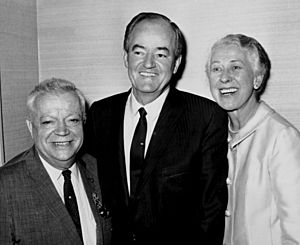David Dubinsky facts for kids
Quick facts for kids
David Dubinsky
|
|
|---|---|
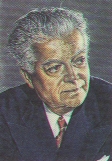 |
|
| Born |
David Isaac Dobnievski
February 22, 1892 Brest-Litovsk, Grodno Governorate, Russian Empire
|
| Died | September 17, 1982 (aged 90) |
| Occupation | Labor leader |
David Dubinsky (born David Isaac Dobnievski; February 22, 1892 – September 17, 1982) was an American labor leader. He led the International Ladies Garment Workers Union (ILGWU) from 1932 to 1966. He also helped create the CIO. Dubinsky was a founder of the American Labor Party and the Liberal Party of New York. He worked hard to improve conditions for workers.
Contents
Early Life of a Labor Leader
David Isaac Dobnievski was born on February 22, 1892. He was the youngest of eight children. His family lived in Brest-Litovsk, which is now Brest in Belarus. When he was almost three, his family moved to Łódź, Poland.
David's father owned a bakery. David helped deliver bread from a young age. He also went to a Hebrew school. There he learned Polish, Russian, and Yiddish. Later, he worked full-time in his father's bakery.
During the Russian Revolution of 1905, David became interested in workers' rights. He joined the bakers' union. This union was part of a Jewish socialist group called the Bund. By 1906, he was an assistant secretary in the union. At 15, David was a strong believer in socialism. This meant he believed in fairness for all workers.
In 1907, David was arrested for helping plan a bakers' strike. He was held for three days. In January 1908, he was arrested again. This time it was for attending a union meeting without police permission. He was not yet 16 years old. David was held in jails for 18 months. He was then sent away to Siberia.
But David escaped while traveling to Siberia. He hid for several months. Then, he managed to get a ticket to the United States. One of his brothers, who lived in New York City, sent it to him. David arrived in America in 1911.
Life in America
Starting Out in New York
When David Dubinsky arrived in America, he started working in a clothing factory in Brooklyn. He joined the Socialist Party. This was after the terrible Triangle Shirtwaist Factory fire. This fire showed how dangerous factory work could be.
Dubinsky then got a job as a cutter. This was a good job in the clothing industry. Many other jobs were in sweatshops, which had very bad working conditions.
He joined Local 10 of the ILGWU. This was the International Ladies Garment Workers Union. He quickly became a leader. In 1918, he was elected to the local's executive board. The next year, he became vice-president. By 1921, he was president of his local union. In 1922, he joined the International's Executive Board.
Union Challenges and Growth
Dubinsky became a vice-president of the ILGWU. The union faced many challenges. One big challenge was dealing with different political groups inside the union. Dubinsky supported removing members of the Communist Party from leadership roles. He believed they caused too much trouble.
In 1926, a big strike was called in New York. It involved many clothing workers. But this strike did not go well. It caused a lot of problems for the union. After this, the Communist Party's influence in the union became much weaker.
Becoming a Top Leader
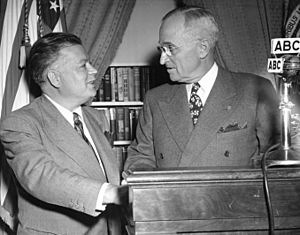
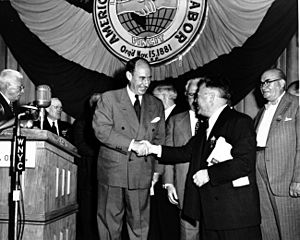
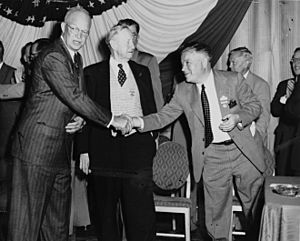
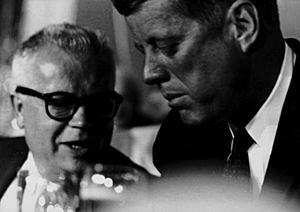
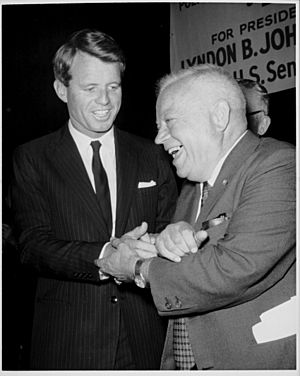

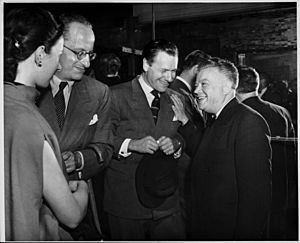
After the difficult strike, Dubinsky worked to rebuild the ILGWU. He made a deal with clothing manufacturers in 1929. This deal did not raise pay. But it allowed the union to make sure companies followed the rules. This helped stop some businesses from cheating workers.
Dubinsky was elected Secretary-Treasurer of the ILGWU in 1929. Then, in 1932, he became President. He held both jobs for many years. He was President until 1966. He was known for being a very strong leader. He made sure everyone knew who was in charge. He once said, "We have a democratic union – but they know who's boss."
Even though most union members were women, most leaders were men. This was a challenge for the union.
Organizing During the Great Depression
The Great Depression made things very hard for the ILGWU. Many unionized shops closed. Membership dropped a lot. But things changed after Franklin D. Roosevelt became president. A new law, the National Industrial Recovery Act, promised to protect workers' rights to organize.
This law helped the union grow quickly. In 1933, the union called a strike of dressmakers in New York. More than 70,000 workers joined. This was twice as many as expected! By 1934, the union had over 200,000 members. By the end of the Depression, it had about 300,000.
The ILGWU was one of the few unions that organized all workers in an industry. This is called industrial unionism. Dubinsky helped create the Committee for Industrial Organization in 1935. This group wanted to organize workers in big industries like steel and cars. The ILGWU gave them important money and help.
However, Dubinsky did not want to split the main labor group, the AFL. He also did not like working with Communist Party members. So, the ILGWU eventually rejoined the AFL in 1940. Dubinsky became a vice president of the AFL. He pushed for unions to be honest and fair.
Politics and New Parties
Dubinsky was also very active in politics. He helped start the American Labor Party (ALP) in 1936. This party was for people who supported liberal politicians like President Roosevelt. But they did not want to join the main Democratic Party.
The ALP faced its own disagreements. Dubinsky eventually left the ALP in 1944. He disagreed with other leaders about working with people who supported the Communist Party. Dubinsky and his friends then formed the Liberal Party of New York.
The ILGWU strongly supported Harry S. Truman in the 1948 presidential election. They worked hard to help him win. Dubinsky hoped to start a national liberal party. He wanted to work with Wendell Willkie, a Republican who had changed his views. But Willkie died before this plan could happen.
Dubinsky and the ILGWU stayed active in the Liberal Party for many years. Their support ended after Dubinsky retired in 1966.
Changes After the War
Dubinsky believed the union helped the clothing industry. He thought it made the industry more stable. He even said that "workers need capitalism the way a fish needs water." This meant he believed workers needed a strong economy to do well.
After World War II, the clothing industry changed a lot. Factories moved away from New York City. They went to places where unions were not strong. Wages were also much lower there. The ILGWU found it hard to organize workers in these new places.
The union's members also changed. It used to be mostly Jewish and Italian workers. After the war, it became mostly Latino, African-American, and Asian workers. The union's leaders often did not have the same background as the new members.
Some new members tried to get more power in the union. But the existing leaders had a strong hold. The union continued to grow for a while. It reached 500,000 members in 1965, just after Dubinsky retired.
However, the union slowly lost its strength. It became harder to stop bad working conditions. The ILGWU eventually merged with another union in 1995. This new union was called UNITE.
David Dubinsky received the Presidential Medal of Freedom on January 20, 1969. This is a very high honor in the United States. He passed away on September 17, 1982, in New York City.
|


